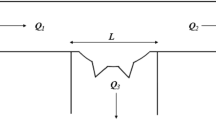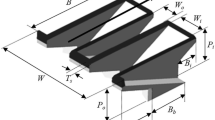Abstract
The piano key weir (PK-Weir) is a hydraulic structure used in the irrigation system by its construction on artificial or natural channels such as rivers or irrigation canals, it may be in the submerged state due to an increase in flow or an obstacle downstream of the PK-Weir. Therefore, this type of weir has been the subject of several experimental studies in order to understand the phenomenon of streaming flow on the weir, which led to the development of empirical relationships describing the effects of streaming flow on hydraulic performance. Experimental studies are essential for the design of weirs, but they require a lot of time to collect a real database. The main objective of this paper is to predict the relative head of PK-Weir for submerged flow using artificial neural networks. To do this, we have used the results of our experimental study to develop a neural model. The results obtained were very satisfactory with very acceptable errors (RMSE = 0.0133 and MAE = 0.0066). In addition, a comparative study was made between empirical relationships and the developed model. The results of this comparative study showed a good agreement.













Similar content being viewed by others
Abbreviations
- B :
-
Upstream–downstream length of the PK-Weir (cm)
- B 0 :
-
Upstream (outlet key) overhang crest length (cm)
- B i :
-
Downstream (inlet key) overhang crest length (cm)
- B b :
-
Base length (cm)
- C W :
-
Flow coefficient (−)
- g :
-
Gravity acceleration (cm/s2)
- H u :
-
Total upstream head (cm)
- H d :
-
Total downstream head (cm)
- H o :
-
Total upstream head (cm)
- h u :
-
Upstream piezometric head (cm)
- h d :
-
Downstream piezometric head (cm)
- h 0 :
-
Upstream piezometric head (cm)
- P i :
-
Height of the inlet entrance measured from the PK-Weir crest (cm)
- P 0 :
-
Height of the outlet entrance measured from the PK-Weir crest (cm)
- Q :
-
Volumetric discharge (l/s)
- V u :
-
Flow velocity at upstream (cm/s)
- V d :
-
Flow velocity at downstream (cm/s)
- V 0 :
-
Flow velocity at upstream (cm/s)
- W T :
-
Total width of the PK-Weir (cm)
- W u :
-
Width of a PK-Weir unit (cm)
- W i :
-
Inlet key width (sidewall to sidewall) (cm)
- W 0 :
-
Outlet key width (sidewall to sidewall) (cm)
- T S :
-
Sidewall thickness (cm)
- L :
-
Total developed length along the overflowing crest axis (cm)
- Z :
-
Difference between the total upstream head and total downstream head (Z = Hu − Hd) (cm)
References
Ouamane A, Lempérière F (2003) The piano keys weir: a new cost-effective solution for spillways. Int J Hydropower Dams 10(5):144–149
Tullis BP, Dabling MR (2012) Piano Key Weir Submergence in Channel Applications. International Workshop on Piano Key Weir for In-Stream Storage and Dam Safety (PKWISD-2012), New Delhi, India
Kabiri-Samani A, Javaheri A (2012) Discharge coefficients for free and submerged flow over piano key weirs. J Hydraul Res 50:114–120
Cicero GM, Delisle JR (2013) Discharge characteristics of Piano Key weirs under submerged flow. Proc. of the Int. Labyrinth and Piano Key Weirs II-PKW 2013, Leiden: CRC Press, pp 101–108
Cicero GM, Vermeulen J, Laugier F (2016 ) Influence of some geometrical parameters on piano key weir discharge efficiency. Paper presented at the meeting of 6th international Symposium on Hydraulic Structures Hydraulic Structures and Water System Management, Portland, Oregon, USA
Belaabed F, Ouamane A (2019) Etude des déversoirs non rectilignes noyés par l’aval. Biskra University, Algeria, Doctorat These
Shahid N, Rappon T, Berta W (2019) Applications of artificial neural networks in health care organizational decision-making: a scoping review. PLoS ONE. https://doi.org/10.1371/journal.pone.0212356
Berrezzek F, Khelil K, Bouadjila T (2019) Efficient wind speed forecasting using discrete wavelet transform and artificial neural networks. Revue d’Intell Artif. https://doi.org/10.18280/ria.330607
Krzywanski J, Nowak W (2012) Modeling of heat transfer coefficient in the furnace of CFB boilers by artificial neural network approach. Int J Heat Mass Transf 55(15–16):4246–4253. https://doi.org/10.1016/j.ijheatmasstransfer.2012.03.066
Krzywanski J, Blaszczuk A, Czakiert T, Rajczyk R, Nowak W (2014) Artificial intelligence treatment of NOX emissions from CFBC in air and oxy-fuel conditions. CFB-11: Proceedings of the 11th International Conference on Fluidized Bed Technology, pp 619–624
Liukkonen M, Heikkinen M, Hiltunen T, Hälikkä E, Kuivalainen R, Hiltunen Y (2011) Artificial neural networks for analysis of process states in fluidized bed combustion. Energy 36(1):339–347. https://doi.org/10.1016/j.energy.2010.10.033
Hamrouni A, Sbartai B, Dias D (2018) Probabilistic analysis of ultimate seismic bearing capacity of strip foundations. J Rock Mech Geotech Eng 10(4):717–724. https://doi.org/10.1016/j.jrmge.2018.01.009
Hamrouni A, Dias D, Sbartai B (2018) Reliability analysis of a mechanically stabilized earth wall using the surface response methodology optimized by a genetic algorithm. Geomech Eng 15(4):937–945
Hamrouni A, Dias D, Sbartai B (2019) Probability analysis of shallow circular tunnels in homogeneous soil using the surface response methodology optimized by a genetic algorithm. Tunnell Undergr Space Technol 86:22–33
Goudjil, K., & Sbartai, B. (2017). Optimization of shear wave velocity (Vs) from a post-liquefaction settlement using a genetic algorithm multi-objective NSGA II
Hanna A, Ural D, Saygili G (2007) Neural network model for liquefaction potential in soil deposits using Turkey and Taiwan earthquake data. Soil Dynam Earthq Eng. https://doi.org/10.1016/j.soildyn.2006.11.001
Kung G, Hsiao E, Schuster M, Juang C (2007) A neural network approach to estimating deflection of diaphragm walls caused by excavation in clays. Comput Geotech. https://doi.org/10.1016/j.compgeo.2007.05.007
Acharyya R, Dey A (2019) Assessment of bearing capacity for strip footing located near sloping surface considering ANN model. Neural Comput Appl 31(11):8087–8100. https://doi.org/10.1007/s00521-018-3661-4
Shahin MA, Jaksa MB, Maier HR (2002) Artificial neural network based settlement prediction formula for shallow foundations on granular soils. Aust Geomech: J News Aust Geomech Soc 37(4):45
Badreddine S, Goudjil K (2012) Prediction of dynamic impedances functions using an Artificial Neural Network (ANN). Appl Mech Mater, Trans Tech Publ Ltd 170:3588–3593
Goudjil K, Arabet L (2020) Assessment of deflection of pile implanted on slope by artificial neural network. Neural Comput Appl. https://doi.org/10.1007/s00521-020-04985-6
Zounemat-Kermani M, Mahdavi-Meymand A (2019) Hybrid meta-heuristics artificial intelligence models in simulating discharge passing the piano key weirs. J Hydrol 569:12–21
Karami H, Karimi S, Bonakdari H, Shamshirband S (2018) Predicting discharge coefficient of triangular labyrinth weir using extreme learning machine, artificial neural network and genetic programming. Neural Comput Appl 29(11):983–989
Olyaie E, Heydari M, Banejad H, Chau KW (2019) A laboratory investigation on the potential of computational intelligence approaches to estimate the discharge coefficient of piano key weir. J Rehabil Civil Eng 7(1):42–61
Dursun OF, Kaya N, Firat M (2012) Estimating discharge coefficient of semi-elliptical side weir using ANFIS. J Hydrol 426:55–62
Chandran S, Ramachandran R, Cao J, Agarwal RP, Rajchakit G (2019) Passivity analysis for uncertain bam neural networks with leakage, discrete and distributed delays using novel summation inequality. Int J Control, Autom Syst 17(8):2114–2124. https://doi.org/10.1007/s12555-018-0513-z
Saravanakumar R, Rajchakit G, Ali MS et al (2019) Exponential dissipativity criteria for generalized BAM neural networks with variable delays. Neural Comput Appl 31:2717–2726. https://doi.org/10.1007/s00521-017-3224-0
Saravanakumar R, Rajchakit G, Ali MS et al (2018) Robust extended dissipativity criteria for discrete-time uncertain neural networks with time-varying delays. Neural Comput Appl 30:3893–3904. https://doi.org/10.1007/s00521-017-2974-z
Bianchini M, Scarselli F (2014) On the complexity of neural network classifiers: a comparison between shallow and deep architectures. IEEE Trans Neural Netw Learn Syst 25(8):1553–1565
Aggarwal CC (2018) Neural networks and deep learning. Springer, Berlin
Le, Q. V., Jaitly, N., & Hinton, G. E. (2015). A simple way to initialize recurrent networks of rectified linear units. arXiv preprint arXiv:1504.00941
Kiseľák, J., Lu, Y., Švihra, J., Szépe, P., & Stehlík, M. (2020). “SPOCU”: scaled polynomial constant unit activation function. Neural Computing and Applications, 1–17.
Thimm G, Fiesler E (1997) High-order and multilayer perceptron initialization. IEEE Trans Neural Netw 8(2):349–359
Piekniewski, F., & Rybicki, L. (2004, July). Visual comparison of performance for different activation functions in MLP networks. In 2004 IEEE International Joint Conference on Neural Networks (IEEE Cat. No. 04CH37541) (Vol. 4, pp. 2947–2952). IEEE
Özkan C, Erbek FS (2003) The comparison of activation functions for multispectral Landsat TM image classification. Photogram Eng Remote Sens 69(11):1225–1234
Olawoyin A, Chen Y (2018) Predicting the future with artificial neural network. Procedia Comput Sci 140:383–392
Zadeh MR, Amin S, Khalili D, Singh VP (2010) Daily outflow prediction by multi-layer perceptron with logistic sigmoid and tangent sigmoid activation functions. Water Resour Manag 24(11):2673–2688
Isa IS, Saad Z, Omar S, Osman, MK, Ahmad KA., Sakim, HM (2010) Suitable MLP network activation functions for breast cancer and thyroid disease detection. In 2010 Second international conference on computational Intelligence, modelling and simulation. IEEE, pp 39–44
Hagan MT, Demuth HB, Beale MH (2002) Neural network design. University of Colorado at Boulder
Acknowledgements
The model investigation was supported by Laboratory of Hydraulic planning and Environment, Biskra University, Algeria.
Author information
Authors and Affiliations
Corresponding author
Ethics declarations
Conflict of interest
'The researcher claims no conflict of interest'
Additional information
Publisher's Note
Springer Nature remains neutral with regard to jurisdictional claims in published maps and institutional affiliations.
Rights and permissions
About this article
Cite this article
Belaabed, F., Goudjil, K., Arabet, L. et al. Utilization of computational intelligence approaches to estimate the relative head of PK-Weir for submerged flow. Neural Comput & Applic 33, 13001–13013 (2021). https://doi.org/10.1007/s00521-021-05996-7
Received:
Accepted:
Published:
Issue Date:
DOI: https://doi.org/10.1007/s00521-021-05996-7




